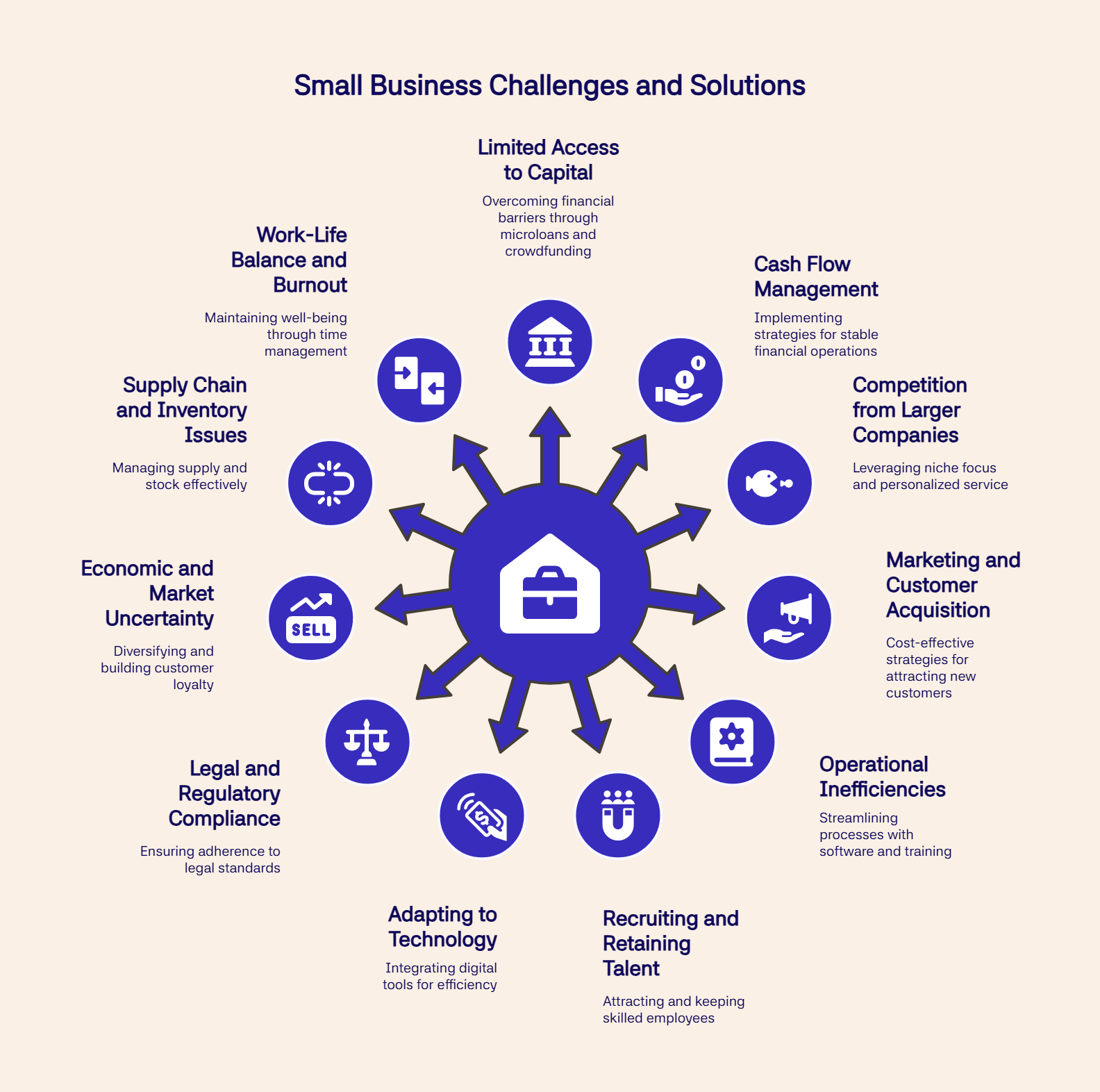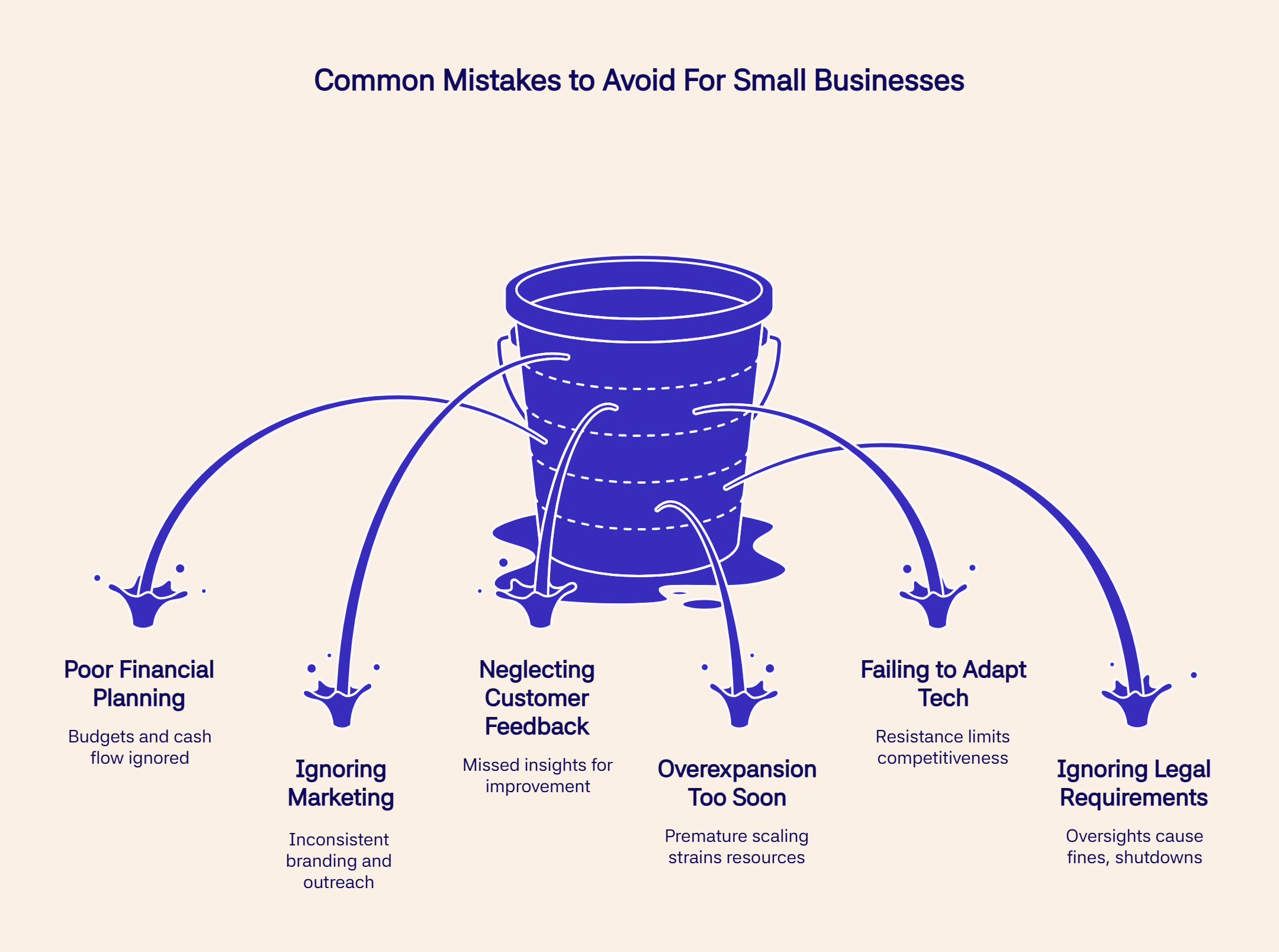Small business owners face 11 critical challenges that directly impact survival and growth, from securing adequate funding to managing daily operations effectively. Understanding these challenges and their solutions determines business success.
Some of the biggest challenges are limited access to capital, trouble managing cash flow, competition from larger companies, and difficulties in marketing and attracting customers. Each of these issues can make it hard to stay stable and grow.
In this blog, you will learn about these key challenges in detail, and each challenge includes specific data on its business impact and proven strategies for resolution.
So, let’s start.
TL;DR:
-
Small business owners face 11 critical challenges including limited capital access (14% struggle with financing), cash flow gaps affecting 82% of businesses, and fierce competition from larger companies
-
Marketing difficulties impact 78% of small businesses, while operational inefficiencies cost 15-20% in lost productivity through manual processes and poor workflows
-
Success strategies include diversifying funding sources, maintaining 3-6 months emergency funds, leveraging personalized customer service advantages, and adopting cost-effective technology solutions
-
Common avoidable mistakes include poor financial planning, ignoring customer feedback, premature expansion, and failing to adapt to new technologies
Common Small Business Challenges & Their Solutions
Small business owners face 11 primary challenges that directly impact growth and profitability, from securing adequate funding to managing daily operations effectively.

Related read: How to start a business in 10 steps.
1. Limited Access to Capital
14% of small business owners struggle with access to financing according to the 2025 Small Business Index survey, making capital access a critical barrier to growth.
Also, many small business owners struggle to get loans from banks because they lack credit history or collateral. Investors also prefer larger companies with proven records, which makes it tough for small firms to secure funding.
This lack of capital limits what businesses can do. They may delay hiring, avoid buying better tools, or miss growth opportunities.
Business owners can access capital through microloans from community banks and nonprofit organizations. Government grants for startups, and crowdfunding platforms that raise money from multiple small contributors.
2. Cash Flow Management
Cash flow gaps between supplier payments and customer receipts create operational challenges for 82% of small businesses, requiring specific management strategies. Small businesses often face gaps between paying suppliers and getting paid by customers.
For example, a shop may pay for stock today but receive payment from clients after 30 days. Poor cash flow can stop a business from paying employees or bills on time.
Effective cash flow management involves 4 proven strategies:
-
Send invoices quickly instead of waiting.
-
Offer small discounts to customers who pay early.
-
Use accounting tools to track payments and expenses in real time.
-
Keep an emergency fund equal to at least two months of expenses.
3. Competition from Larger Companies
Small businesses compete effectively against larger companies through 3 distinct advantages: personalized customer service, faster adaptation to market changes, and specialized niche focus.
For example, a local bakery may not compete with a supermarket on price, but it can win with fresh products and a personal touch.
You can handle competition by:
-
Focusing on niche markets where large companies have less interest.
-
Creating loyal customer communities through social media.
-
Delivering personalized services that big companies cannot match.
4. Marketing and Customer Acquisition
Reaching new customers is one of the hardest jobs for small businesses. Marketing requires money, time, and skills. Traditional advertising is costly, while online marketing is often confusing for beginners.
Without visibility, even the best products go unnoticed. In fact, research shows that 70 to 80% of consumers look up a small business online before contacting it, which means a weak online presence can drive customers away.
Customer acquisition challenges affect 78% of small businesses, but four cost-effective marketing strategies deliver measurable results without large budgets:
-
Social media marketing
-
Word-of-mouth promotion by encouraging satisfied customers to share their experiences.
-
Local SEO (Search Engine Optimization) to appear in Google search results for nearby services.
-
Partnerships with other small businesses to reach more people.
Marketing does not always require big spending, but it needs consistency and creativity.
5. Operational Inefficiencies
Operational inefficiencies cost small businesses an average of 15-20% in lost productivity through manual processes, poor inventory management, and unclear workflows.
For example, using manual records instead of software can lead to errors.
Repeating the same tasks manually, poor time management, and a lack of clear workflow are the most common operational inefficiencies. However, it's not so hard to overcome them.
You can use affordable software for accounting, scheduling, or inventory. Try your best to train employees to follow simple systems. Regularly review operations to eliminate unnecessary steps.
Here is a curated list of the top AI tools for small businesses that'll boost your business productivity.
6. Recruiting and Retaining Talent
Hiring the right people is a big challenge. Small businesses often cannot pay high salaries or provide large-company benefits. As a result, it's become harder to attract skilled workers. Even when good employees join, keeping them motivated is another task.
Small businesses successfully compete for talent through 4 non-monetary advantages:
-
Share a clear mission so employees feel part of something meaningful.
-
Provide flexibility, such as remote work or flexible hours.
-
Offer small but valuable perks like training, mentorship, or career growth.
-
Celebrate employee achievements to build loyalty.
7. Adapting to Technology
62% of small business workers report that generative AI tools help them serve customers more effectively, making technology adoption essential for competitive advantage.
Now, here's is how to adopt technology for your small business:
-
Start with free or low-cost tools such as Google Workspace for emails and documents.
-
Use mobile payment apps to make transactions easier for customers.
-
Create a professional website for your small business so customers can find the business online.
-
Learn through free online tutorials or local workshops.
-
Utilize AI tools that are relevant to your business work.
-
Follow the latest digital marketing trends and apply the suitable one.
8. Legal and Regulatory Compliance
Legal compliance requirements for small businesses include 5 essential areas:
-
Business registration
-
Tax obligations
-
Licensing requirements
-
Employment law
-
Industry-specific regulations.
Missing any of these issues can lead to fines or legal trouble.
Legal compliance involves registering business names with local authorities, maintaining accurate tax records, following employment laws, and consulting legal advisors for complex issues.
9. Economic and Market Uncertainty
Economic uncertainty impacts small businesses disproportionately, with 67% reporting revenue declines during market downturns compared to 34% of larger companies.
You can reduce risks by diversifying products or services so the business does not depend on one source.
Also, it's wise to build relationships with loyal customers who support the business during hard times. You can also stay up-to-date with the latest small business trends and adjust your strategies accordingly.
10. Supply Chain and Inventory Issues
Supply chain disruptions affect 73% of small businesses annually, making supplier diversification and inventory optimization critical operational strategies. If suppliers delay, raise prices, or run out of stock, small businesses suffer.
Inventory mismanagement also creates problems, like too much stock wastes money, or too little stock loses sales.
Here are some tips to manage supply and stock:
-
Work with more than one supplier to avoid total dependence.
-
Track inventory with simple software or even spreadsheets.
-
Forecast demand based on past sales data.
-
Order smaller batches more often to reduce waste.
11. Work-Life Balance and Burnout
Small business owner burnout affects 19% who work more than 60 hours weekly, requiring specific time management and delegation strategies to maintain effectiveness.
How to avoid burnout:
-
Set clear working hours and stick to them.
-
Delegate tasks to employees or outsource when possible.
-
Take short breaks during the day to refresh the mind.
-
Practice simple stress relief methods like walking or meditation.
Common Mistakes to Avoid For Small Businesses
Small businesses often struggle because of poor financial planning, weak marketing, ignoring customer feedback, and failing to adapt to new changes.
Let's learn about the common mistakes in detail so that you can avoid them from the beginning:

Poor Financial Planning
Financial planning mistakes include failing to maintain monthly budgets, not tracking cash flow weekly, and lacking emergency funds equal to 3-6 months of expenses.
Good financial planning means monitoring spending, setting aside savings, and preparing for slow months.
Ignoring Marketing and Branding
Marketing mistakes include inconsistent social media posting, a lack of local SEO optimization, and failing to collect customer testimonials for credibility building. Branding builds trust, while marketing spreads the message.
Even simple steps, such as social media posts or a logo type relevant to the business, can make a significant difference in visibility and growth.
Here are 40+ proven small business marketing ideas you can consider applying immediately.
Neglecting Customer Feedback
Ignoring customer opinions weakens a business. Feedback highlights what works and what needs fixing. Owners who listen to customers can improve products and build loyalty. Simple surveys or online reviews provide insights that guide better decisions.
Overexpansion Too Soon
Premature expansion mistakes include opening new locations before achieving 6 months of positive cash flow, adding products without testing market demand, and hiring staff before establishing clear operational systems.
Failing to Adapt to Technology
Technology is growing quickly, and resisting change makes businesses less competitive. From digital payments to online marketing, tech tools improve efficiency and reach. If you can't adapt to the new technology, you have a big chance of being slower and even being stopped.
Ignoring Local Legal Requirements
Many small businesses skip legal basics like permits, taxes, or employee rules. This can lead to fines or shutdowns. Also, they often don’t value the local legal factors for business.
For example, starting a business in Massachusetts doesn’t require the same documents as in Florida.
FAQs
How much money should I set aside as a safety net for my small business?
Set aside emergency funds equal to at least 3–6 months of operating expenses. This includes rent, payroll, inventory, and utilities. A strong financial cushion helps cover cash flow gaps, market slowdowns, or emergencies that could otherwise halt operations.
What are the best funding options for new small businesses without credit history?
Secure funding without credit history by applying for microloans from community banks or nonprofit lenders, seeking government startup grants, or using crowdfunding platforms. These sources do not require strong credit or collateral and are designed to support early-stage businesses.
How do I know if my business is ready to hire its first employee?
Hire your first employee when your business has at least 6 months of positive cash flow, stable operations, and a clearly defined role that frees up your time for growth tasks. Avoid hiring before your systems and revenue can support the added cost.
What small business software tools save the most time and money?
Use accounting software like QuickBooks or Wave for financial tracking, inventory tools like Zoho or Square, scheduling tools like Calendly, and project management platforms like Trello or Asana. These tools reduce manual work, prevent errors, and streamline daily operations.
How can I tell if my marketing strategy is working?
Measure your marketing performance using key indicators like increased website traffic, lead generation, conversion rates, customer acquisition cost, and return on investment (ROI). If these metrics improve consistently, your strategy is effective.
What’s the difference between growing a small business and scaling it?
The main difference between growing and scaling a small business is that growth increases revenue and resources at the same rate, while scaling increases revenue without a matching rise in costs. Scaling focuses on efficiency and systems that handle more output with fewer inputs.
How do small businesses build credibility in competitive markets?
Build credibility by collecting customer reviews, showcasing testimonials, maintaining a professional online presence, and consistently delivering quality service. Certifications, partnerships, and media mentions also strengthen trust and market reputation.
When is the right time to expand my small business?
Expand your small business after achieving steady profits, positive cash flow for at least 6 months, clear operational systems, and consistent customer demand. Expansion before financial and operational readiness can strain resources and cause setbacks.
What strategies help small businesses compete with larger companies?
Small businesses can focus on niche markets, offer personalized services, build strong customer relationships, use creative marketing, and adapt quickly to trends. Flexibility and personal touch often give them an advantage over big competitors.
How can small businesses survive economic uncertainty?
Businesses can survive uncertain times by diversifying products, controlling costs carefully, and keeping cash reserves. It’s also important to maintain loyal customers, monitor market trends, and adjust strategies quickly to respond to changes in demand or prices.
End Note
Undoubtedly, running a small business is rewarding but comes with challenges. Many owners struggle with limited access to capital, cash flow management, and attracting customers. These issues can slow growth, but understanding them is the first step to overcoming them.
By planning carefully, adopting simple technology, and focusing on customer needs, small businesses can stay strong and competitive. Learning from common challenges helps owners make better decisions and build a business that lasts.





